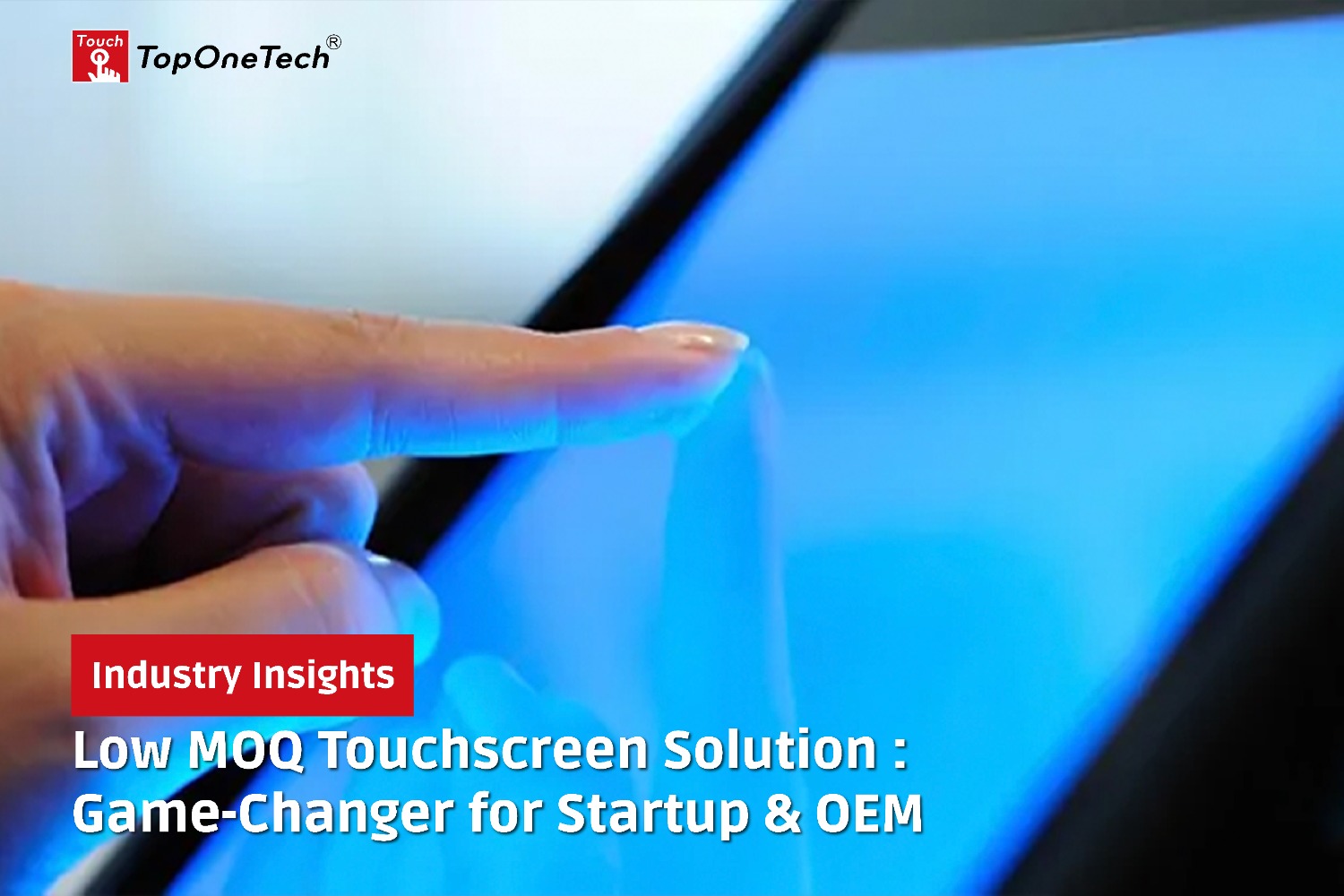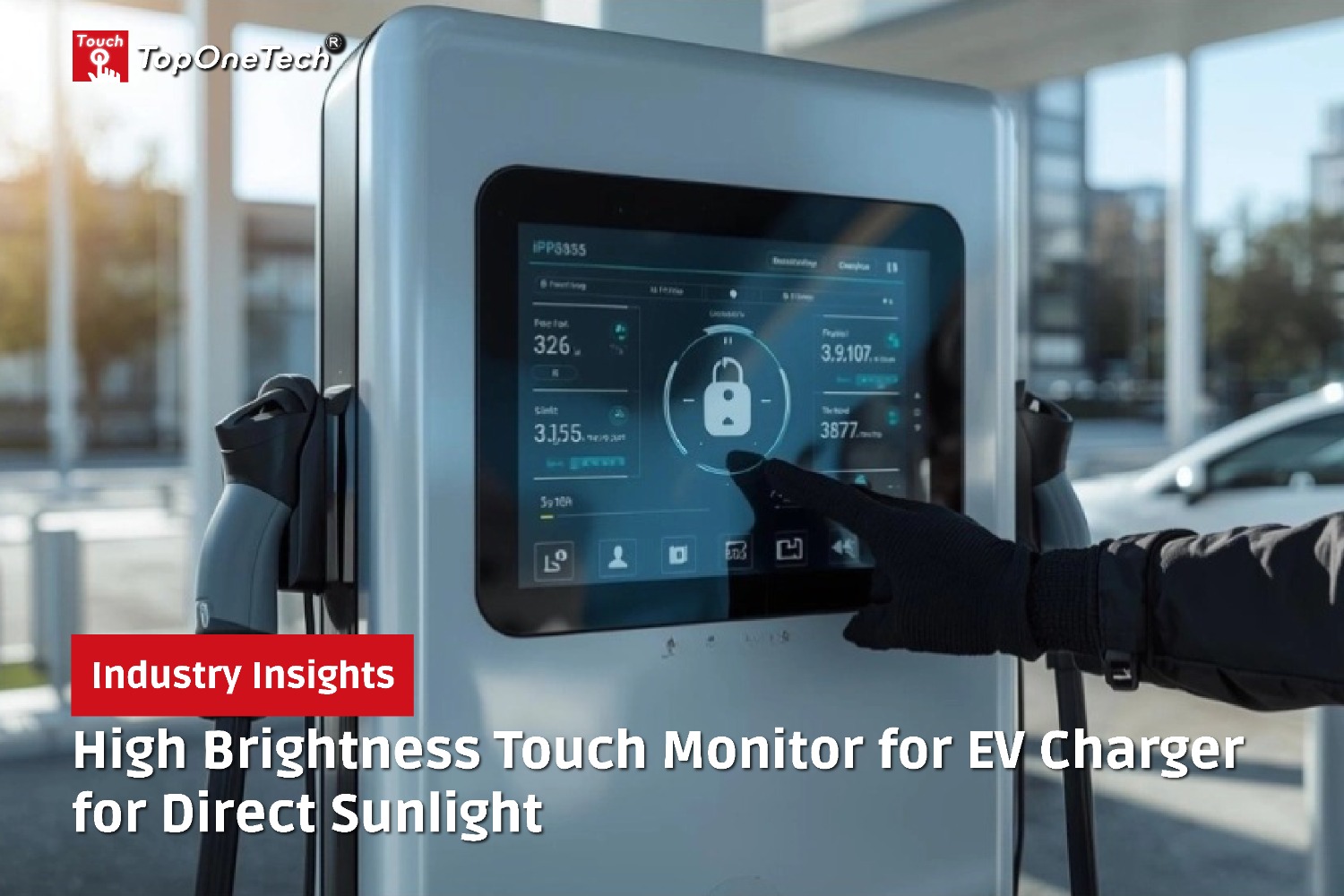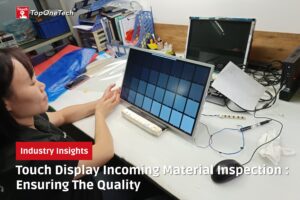
Touch Display Incoming Material Inspection: Ensuring The Quality – At Top One Tech, we prioritize quality at every stage of production, which is why we always conduct thorough Touch Display Incoming Material Inspections. By inspecting each touch display meticulously upon arrival, we ensure that every LCD screen meets our high standards for display effect, touch functionality, and electronic performance. Our rigorous inspection process helps detect any potential defects, such as dead pixels, screen distortion, or light leakage, before they reach the production line. This commitment to quality control not only guarantees that our products are reliable and perform seamlessly but also enhances customer satisfaction and trust in the Top One Tech brand.
The Purpose of Touch Display Incoming Material Inspection
The primary goal of inspecting touch display materials is twofold:
- Quality Assurance: Ensure that all touch LCD screens meet the company’s established quality standards and align with customer requirements.
- Production Efficiency: Guarantee that the displays are free from defects that could disrupt the production process, enhancing overall product reliability.
By rigorously inspecting incoming materials, manufacturers can:
- Avoid quality-related production delays.
- Minimize the risk of customer complaints and product returns.
- Build trust in their brand by delivering reliable and high-performing touch displays.
Touch Display Incoming Material Inspection – Inspection Process and Standards
To ensure consistent quality, manufacturers implement a structured inspection process. Moreover, this process covers visual, functional, and electronic performance evaluations, with each step tailored to detect specific defects and inconsistencies.
1. Comprehensive Full Touch Display Incoming Material Inspection
Comprehensive Full Touch Display Incoming Material Inspection is a thorough quality control process that involves examining and testing all incoming materials, particularly touch displays (such as LCD, LED, and touchscreens), to ensure they meet the specified quality standards before they are used in production. This inspection process is essential to prevent defects in the final product, ensuring that the displays function as intended, have no defects, and meet performance specifications.
2. Appearance Inspection and Size Verification
Appearance Inspection and Size Verification are essential quality control processes used to ensure that displays and touchscreens, meets visual and dimensional standards before it proceeds to the next stages of production or is delivered to customers. Moreover, these checks help identify defects and ensure that the product’s size matches its specifications.
Key Objectives:
- Identify visible defects such as scratches, cracks, or irregularities on the surface of the touch screen.
- Confirm that the dimensions align with the required specifications.
Inspection Steps:
- Examine the LCD screen under proper lighting conditions.
- Use precision tools like calipers or measuring tapes to verify size accuracy.
Common Issues Detected:
- Surface scratches or scuffs.
- Misaligned or non-standard dimensions.
3. Resolution and Voltage Testing
Resolution and Voltage Testing is a critical quality assurance process used to verify the performance and compatibility of electronic displays, such as touchscreens and LCD panels. Moreover, it ensures that the screen delivers the expected visual clarity (resolution) and operates correctly within the specified electrical parameters (voltage). Furthermore, this testing is essential for maintaining product reliability, functionality, and user experience.
Testing Procedure:
- Connect the LCD screen to the appropriate testing equipment.
- Set the resolution and voltage parameters according to the manufacturer’s specifications.
- Monitor for any discrepancies in display output or power consumption.
Purpose:
This step ensures that the touch display functions seamlessly under expected operating conditions, minimizing the risk of performance issues during usage.
4. Functional Testing
Functional testing is a type of quality assurance process focused on verifying that a product, system, or component performs its intended functions correctly and meets specified requirements. Moreover, this testing ensures that all features and functionalities work as expected under normal and edge-case scenarios. Additionally, it is typically conducted on software, electronic devices, or hardware systems and plays a critical role in product reliability and customer satisfaction.
Key Areas of Functional Testing
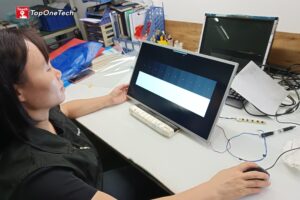
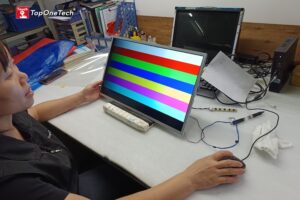

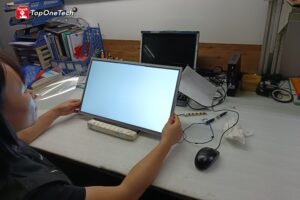
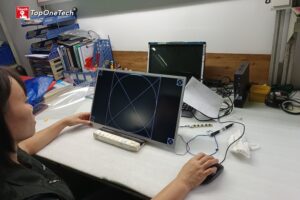
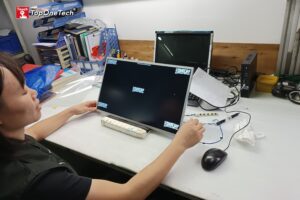
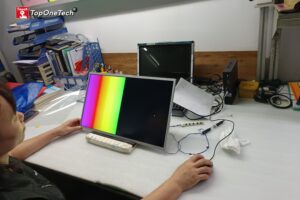
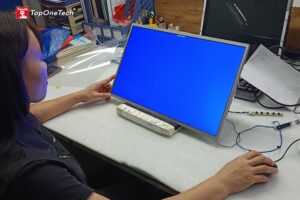
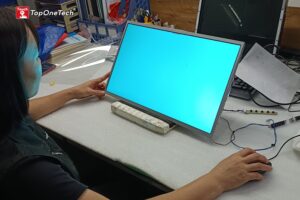
- Dead Pixel Inspection:
- Dead pixels can severely impact the visual experience.
- Test by displaying solid colors (red, green, blue, black, and white) across the screen to identify non-functional pixels.
- Screen Distortion Analysis:
- Distorted displays may indicate underlying issues in the LCD structure.
- Observe the screen for warping or uneven brightness distribution.
- Light Leakage Testing:
- Light leakage, often visible around the screen edges, can degrade the user experience.
- Test in a dark environment to detect any areas of unwanted light emission.
- Brightness Inspection:
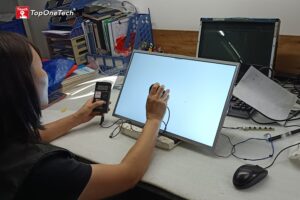
-
- Ensure that the screen meets the required brightness levels.
- Measure brightness using a lux meter or other industry-standard tools.
Benefits of a Rigorous Touch Display Incoming Material Inspection Process
A well-defined inspection process delivers several benefits:
1. Enhanced Product Reliability
Enhanced Product Reliability refers to the improved ability of a product to perform its intended functions consistently and without failure over a specified period under normal usage conditions.
When applied to manufacturing and quality control, it signifies:
- Durability: The product lasts longer and withstands wear and tear.
- Consistency: It delivers the same level of performance every time it is used.
- Reduced Failures: The likelihood of defects, malfunctions, or breakdowns is minimized.
Enhanced product reliability means ensuring that each display screen operates flawlessly, maintains its visual clarity, touch sensitivity, and electronic performance, and provides a dependable user experience throughout its lifecycle. This builds customer trust and satisfaction while reducing costs associated with repairs and replacements.
2. Cost Savings
Cost savings refers to the practice of reducing expenses or avoiding unnecessary expenditures without compromising the quality, efficiency, or functionality of a product, service, or operation. Moreover, it is a critical objective for businesses, organizations, and individuals to improve financial health, increase profitability, and allocate resources more effectively.
3. Improved Customer Satisfaction
Improved customer satisfaction refers to the enhancement of a customer’s overall experience with a product, service, or brand. It occurs when a company consistently meets or exceeds customer expectations, building trust, loyalty, and a positive reputation. Moreover, satisfied customers are more likely to return, recommend the brand to others, and contribute to the organization’s long-term success.
Advanced Techniques in Touch Display Incoming Material Inspection
Modern touch display inspections often incorporate advanced technologies to improve accuracy and efficiency.
Automated Optical Inspection (AOI)
Automated Optical Inspection (AOI) is a technology-driven inspection method used to analyze and detect defects in manufactured products, particularly in industries like electronics, touch display manufacturing, and printed circuit boards (PCBs). Moreover, AOI systems utilize high-resolution cameras, advanced imaging software, and algorithms to examine components for defects, inconsistencies, or deviations from design specifications.
Electrical Performance Testing
Electrical Performance Testing is a quality assurance process used to evaluate the electrical characteristics and functionality of a component, device, or system. Moreover, it ensures that the electrical performance meets the specified requirements and operates reliably under expected conditions. This type of testing is crucial in industries such as electronics, automotive, aerospace, and manufacturing, where electrical integrity directly impacts product functionality and safety.
Conclusion
In conclusion, touch display incoming material inspection is a vital step in the production process, ensuring that every screen meets stringent quality standards. By adopting a meticulous inspection approach, manufacturers can deliver reliable products that meet customer expectations while optimizing production efficiency. Finally, with advancements in technology, the future of touch display inspection promises greater accuracy and speed, paving the way for innovative and high-performing devices.
About Top One Tech
Top One Tech is The Best OEM&ODM Touch Display Manufacturer specializing in the R&D, customization, production and sales services of touch screens, touch monitors and all-in-one touch computers that can be integrated with various machines that are used in multiple industries including casinos, banking, industrial automation, medical equipment, point-of-sale, retail and transportation, industrial equipment, kiosks, etc.
We generally can make touch displays for ATMs, Kiosks, gaming machines, etc. We accept small-volume customization requirements and aim to grow hand in hand with our customers.
Top One Tech also has a branch that can provide sheet metal product customization and production including metal cases, metal cabinets, metal parts, as well as whole ATMs, kiosks, vending machines, etc.
Top One Tech can customize Touch Display specially made for your application scenarios.
Don’t hesitate to contact us for further assistance :
Whatsapp/Call us at : +86 13631610695
Email : sales@toponetech.cn
See Also : Our Wide Range of Touch Display Products


